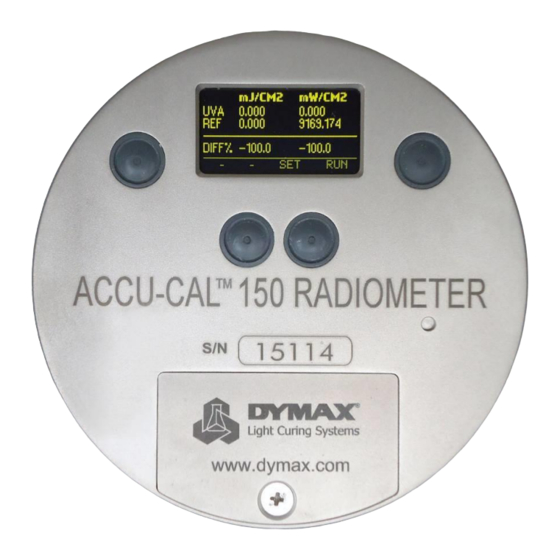dymax ACCU-CAL 150 Podręcznik użytkownika - Strona 12
Przeglądaj online lub pobierz pdf Podręcznik użytkownika dla Przyrządy pomiarowe dymax ACCU-CAL 150. dymax ACCU-CAL 150 20 stron. Uv radiometer

12
Dymax ACCU-CAL™ 150 Radiometer User Guide
WARNING:
Do not use acetone on the Display Window.
Other suitable solvents for cleaning the optics include de-ionized water, methyl alcohol, and ethyl alcohol.
Customers working with non-polar chemicals may find Methyl-ethyl-ketone (MEK) to be an effective solvent.
Customers should avoid using solutions containing detergents.
STEP 4. WIPE
Using a lint-free wipe or a cotton swab, wipe the optical surface clean. Either the wipe or swab needs to be
thoroughly wet with the solvent so the surface tension of the solvent will allow the contaminant to be
captured on the wipe. Users may find it convenient to start again at Step 3 with a second solvent. A source
for lint-free wipes is Kimberly Clark, Inc.'s Kimwipes
Dymax does not recommend wiping the optical surface with a dry wipe or swab of any kind. The absence of
solvent greatly increases the chance for the optical surface to be abraded.
Dymax can provide cleaning advice, assistance, and repair or replacement in cases where these guidelines fail
to remove contaminants. Following these guidelines will help customers get long life and accurate readings
from their radiometers.
Dymax recommends that ACCU-CAL™ 150 be calibrated every 6 months.
Battery Replacement
NOTE: The ACCU-CAL™ 150 should be turned OFF before the batteries are replaced.
Loosen the screw on the Battery Door and remove the door.
Remove the old batteries.
Install two new AAA-size alkaline cells, observing polarity. Both cells are installed in the same direction
(Figure 6). The proper direction is indicated on the PCB and on the housing inside the battery
compartment. The unit is designed so it will not operate with reversed cells.
Replace the Battery Door and the screw.
Figure 6. Direction of Batteries
®
.
